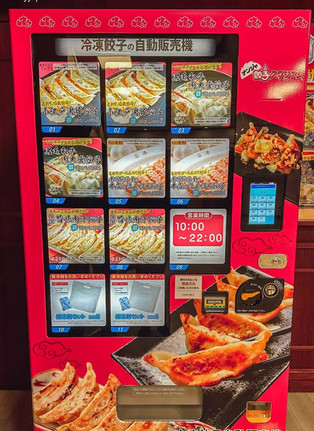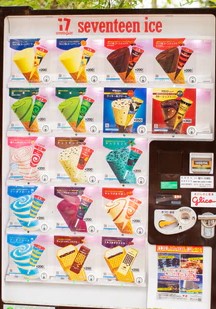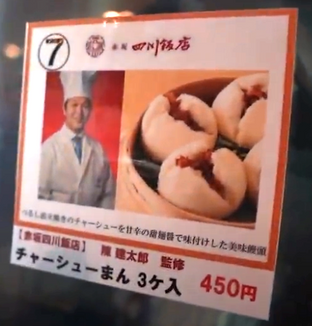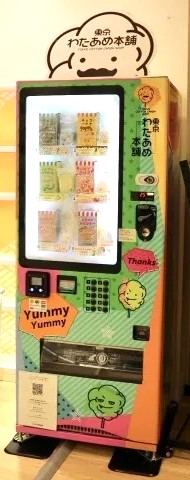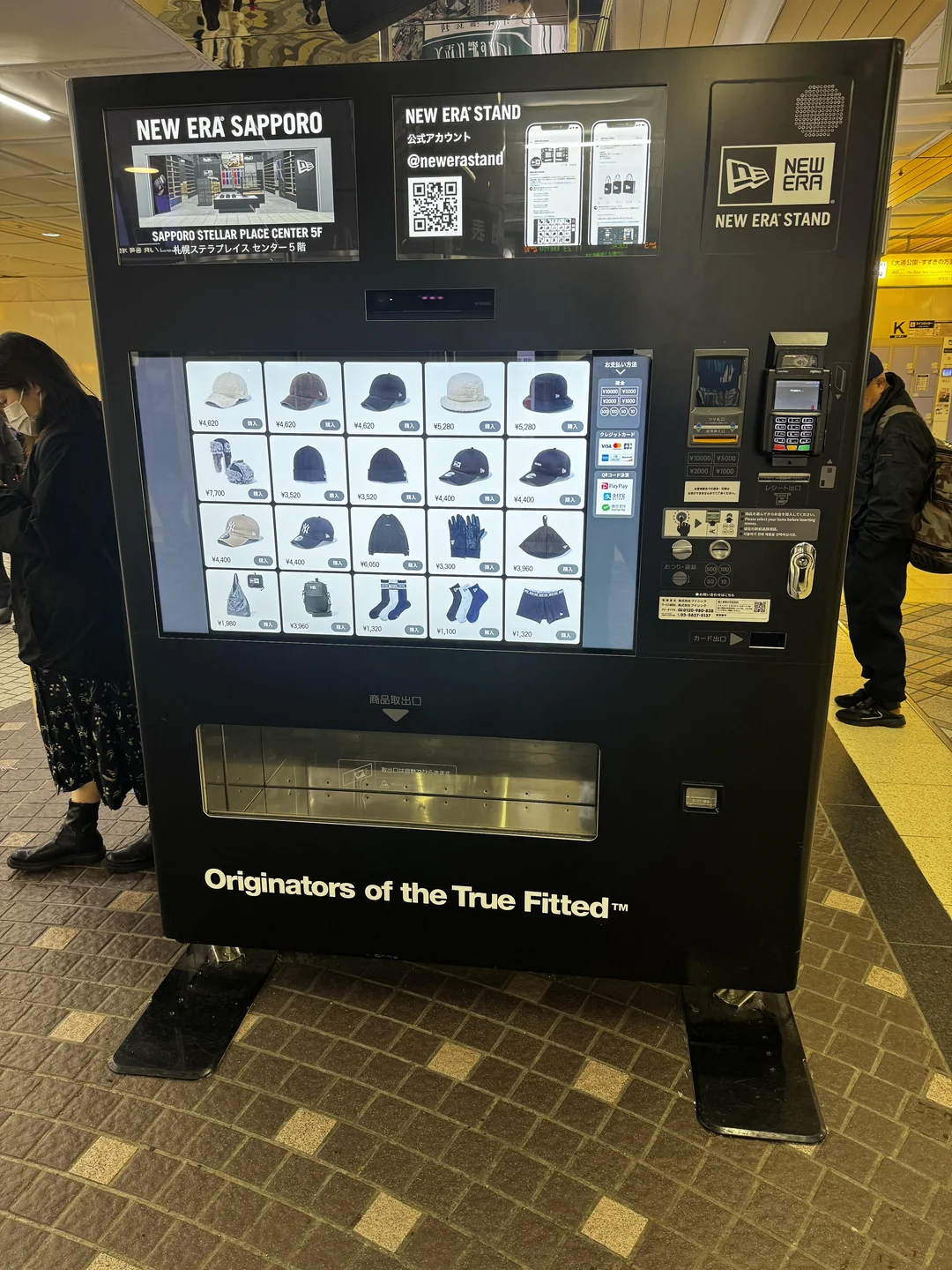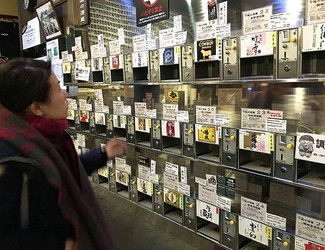Beyond Belief: The Wild Wonders of Japanese Vending Machines
- pwoldow
- Feb 25
- 7 min read
Updated: Feb 28

So here you are in your rental car on a narrow country road or deep in the mountains, far off the beaten path and far from any city, any town, any farm, any sign of human habitation. Then, just as you find yourself feeling a little peckish, you see an illuminated flash of bright red up ahead. As you draw closer, you find a single power pole centered in a small traffic turnout with a cable extending down past a trash receptacle…and plugged into a shiny, fully-stocked vending machine.
Your astonishment grows as you see that this machine is loaded not only with the usual cold beverages―soft drinks, various teas, assorted beers and Suntory highballs―but also has a row from which you can select hot foods―hot coffee, corn soup, canned oden, and rice noodles with various toppings. To top off your impromptu feast on the highway, you select Oshiruko, Japanese red bean dessert soup.

Welcome to the wonderful gifts of Japanese vending machines. Whether you're strolling through the bustling streets of Tokyo, exploring a quiet mountain village, or relaxing in the lobby of your ryokan, you’ll find that vending machines are a constant presence in Japan—dotting sidewalks and train platforms in neat rows, and even appearing in the tranquil grounds of temples and shrines.

A Japanese Vending Machine Wonderland

Japan’s love affair with vending machines runs deep, with a wild assortment of machines catering to every taste and whim imaginable. They’re not just practical—they’re cultural icons, offering a delightful glimpse into both Japanese innovation and its sense of humor. They are a testament to Japan’s knack for making everyday life a little more exciting, for making every consumer product just a little bit better, a bit more easily available.

Japan’s unique social conditions have played a key role in the success of vending machines. Unlike many countries where security and vandalism concerns limit machines’ placement to indoor spaces, Japan’s low rates of vandalism and petty crime mean that machines can be safely installed outdoors, making them accessible 24/7 in almost any location.

A Vending History
From the hyper-urban streets of Shibuya to the serene paths of a Kyoto temple, Japan has done with vending machines what it does with so many other technologies: taken them to the next level. With about 4 million machines in service nationwide, there’s roughly one vending machine for every 32 people in Japan.

The vending machine boom began in the late 1950s, when mechanical vending machines first started competing with products sold by vendors in markets and stalls. Fully automated machines, including fountain-style soda dispensers, soon became widespread, offering a refreshing drink for just 10 yen—a bargain even then. Today, vending machine prices obviously vary widely depending on the purchase, but as a general rule they represent a cost-effective approach to purchasing, if not outright bargains.
The real game-changer came in the 1970s with the introduction of machines that could serve both hot and cold beverages (and later, even frozen products) from a single unit. Suddenly, vending machines weren’t just convenient—they were innovative. This dual-temperature technology revolutionized the industry and cemented Japan’s reputation as a global leader in vending machine culture.

Fast-forward to the 21st century, and today Japanese vending machines have hot, cold and frozen sections that dispense everything from canned bread and fresh eggs to adult toys and luxury goods.

So, What Products Are Available?
Starting with the most banal and moving through the ridiculous to the sublime, here is a list of just some of the items your yen will buy you:
Candy and Gum, Cotton Candy, of course, plus Red Bean Sweets, Ice Cream Cookies, Bars and Soba Ice Cream
Soda, Beer, Cocktails, Water, Green Tea, Macha Tea, fresh-squeezed Orange Juice
Coffee, Latte, Americano, Cappuccino
A huge variety of Bento Boxes, Rice both cooked and uncooked
Sushi, Katsu Curry, Nabe Hot Pot, Okonomiyaki
Rice Noodles and Ramen with various toppings
Popcorn, Pizza, Bagels, Beef Jerky and Celebrity Ramen Kits
Hamburgers, Cheeseburgers. Yakitori and Fried Fish
Black Sesame Tofu and grilled Sweet Potatoes (wonderful!), Flying Fish Dashi
Soup: Corn, Miso, Onion, Clam Soup and Clam Chowder
All kinds of Cake, Okashi Gaku Cakes, French Macaron, fruit-filled Crepes, Basque Cheesecake
Mochi, Char Siu Buns, Canned Bread and all manner of Rice Crackers
Fruit, Bananas, Persimmons, Yogurt, Oranges, and fresh cut Apple Slices
Fresh Salad and Cherry Tomatoes, Tsukemono and Oshinko pickles, Siracha

Wait! Perhaps You Want Something Practical…or a Little Different

Toilet Paper, an Umbrella, Diapers, Hair Decorations
Cold Remedies and Energy Supplements
Fabric (in case you want to sew)
Marital Aids and Sex Toys
Sake (and, of course, Sake Hangover Remedies) and CBD products
Insect Snacks and Horror Sweet Snacks in the shapes of assorted body parts
Underwear, Tee Shirts, Socks, Neckties
Personalized sports shirts and tote bags
Personalized Hanko (Japanese signature seals)
Fortune slips, Idol Cards and Mystery boxes (contents unknown until opened)
Fresh flowers
Used Lingerie
New era Clothing

Want to Wade Into the World of Luxury Items?

Wagyu and Kobe Beef, Ox Tongue or Caviar
Wild Meats, like Boar and Venison
Gold bars and coins
Aroma Therapy Fragrances
Shiseido Cosmetics


A Fine Way to Buy Technology and Toys:

Phone Chargers, Power Banks and All types of batteries
USB Cables, Earbuds, Headsets, Phone Cases, Screen Protectors
Miniature Fans, LED Lights and Handheld Air Purifiers
Disposable Cameras and Memory Cards
Mini Craft Kits for Origami and Plastic Bugs
Trading Cards, Replicas of Famous Japanese Landmarks and Anime Figurines
Plush Toys of countless sizes, shapes & types
And At the Cutting Edge...
Kanebo Cosmetics has developed a vending machine that uses AI to analyze a person's facial features & recommends 4 optimal eyeshadow colors out of 350,000 combinations.

All This Raises Two Questions…
For travelers accustomed to seeing beat-up and poorly-serviced machines in their home countries, the variety and ubiquity of the Japanese vending machine market raises two pressing questions:
1. Is the product safe?

2. Is the product any good?

To both questions, the overall answer is “Yes.” In Japan, vending machine food quality and safety go hand-in-hand, and both wear the unmistakable mark of enormous pride and attention to detail. The vending machine market is a respected first-class endeavor throughout Japan, so whether it’s a matter of purchasing a cricket snack or a small bar of 24-karat gold from a machine, Carly Simon’s song lyric comes to mind: “Nobody does it better.”

Japan’s highly regulated vending machine ecosystem helps maintain their reputation for reliability, cleanliness, and safety. Machines dispensing food or drinks are regulated under the Food Sanitation Act, and operators must maintain proper hygiene standards, including temperature controls for perishable items, even for items like canned coffee or cold drinks.

Machines selling alcohol or tobacco require additional safeguards to restrict access to minors, often requiring an age verification card (TASPO card). A myriad of other laws and regulations govern machine operation, including local zoning laws, energy efficiency standards, waste management laws, and even fire safety laws.

As for freshness and taste, when you open your package, you’ll swear that there must be swarming armies of restockers all across the country who pride themselves in the constant daily ritual of refreshing vending machine supply. We recently opened a premium-quality canned Okashi Gaku Cake―absolutely delicious and of premium bakery quality―and found a fresh dewy strawberry on top that could not have been there for more than a couple of hours.

Also, demand compels freshness: the machines must be restocked often because they sell out so quickly, especially those offering esoteric goods or fresh commodities. On Sado Island, we saw a machine dedicated entirely to fresh persimmons and watched a long line of buyers form as a farmer reloaded his shiny, modern machine. The moment he closed the front panel, there was a customer stampede.

As for the quality of hot foods, no one is going to mistake vending machine katsu curry for Michelin two-star fare, of course, but visitors sampling the enormous variety of packaged vending machine product report that the hot foods are surprisingly tasty.

So, Who’s Minding the Store?
No matter where you go, you’ll find that the machines are well-tended and well-stocked, even where scores of them are positioned side-by-side. So, who tends and mends those four million machines?
There are several ownership models for vending machines in Japan:
Large Manufacturers and Leasing Companies
Major beverage companies like Coca-Cola Japan, Suntory, Kirin, and Asahi own a significant portion of beverage vending machines. They use these machines to distribute their own brands of drinks and snacks efficiently. Vending machines offering tech gadgets, skincare, or specialty products tend to be owned and serviced by technology and retail giants like Panasonic, Fujitsu and Shiseido.
These companies have dedicated teams of subcontracted servicing to maintain the machines, restock products, and handle cash collections or electronic payment systems.

Specialty Product Companies
Businesses focusing on niche markets, like vending machines for caviar, gold, or anime merchandise, usually own and manage these machines to maintain their unique brand image.
These specialty machines are serviced by specialized teams trained to handle specific products.
Independent Operators
Some individuals or smaller firms run vending machines as their primary entrepreneurial businesses. They may place machines in strategic locations by negotiating agreements with property owners or municipalities. Independent operators usually handle restocking and maintenance themselves or hire small servicing teams.
Small Businesses, Farms and Families
Local shop owners or small businesses purchase or lease vending machines to supplement their income. They stock these machines with products they sell or items that cater to local demand. Some restaurants or farms install vending machines to sell their specialty items, such as fresh produce or prepared foods.
These vending machines are typically managed directly by the owners or small local servicing companies.

No matter who is responsible for stocking and maintenance, attention to machine maintenance and product quality to be religious because the vending machine market is so highly competitive.

Yes, the variety is endless and constantly expanding. We welcome you to post photos of unusual vending machines you discover in Japan.
Unique Vending Machines in Japan: A World of Surprises. Everywhere you look, anything you want.
Pokemon Beverages, Shisedo Cosmetics, Soy Sauce
Popcorn, Canned Udon, Bagged Rice
Glass Noodle Entrees, Fresh Bananas, Gyoza
Fan Idol Cards, Fresh Cheeses, Fresh Flowers
MORE Ice Cream, Char Siu Buns, Fried Fish
Aroma Therapy, Cotton Candy, CBD Products
New Era Sport Clothing, Used Lingerie, Kobe Beef
Sake Shots, Chewing Gum, Hangover Nostrums
Pokemon Pilot & Attendant, Claw Plush Vending, Pokemon Singin' & Dancin'

















